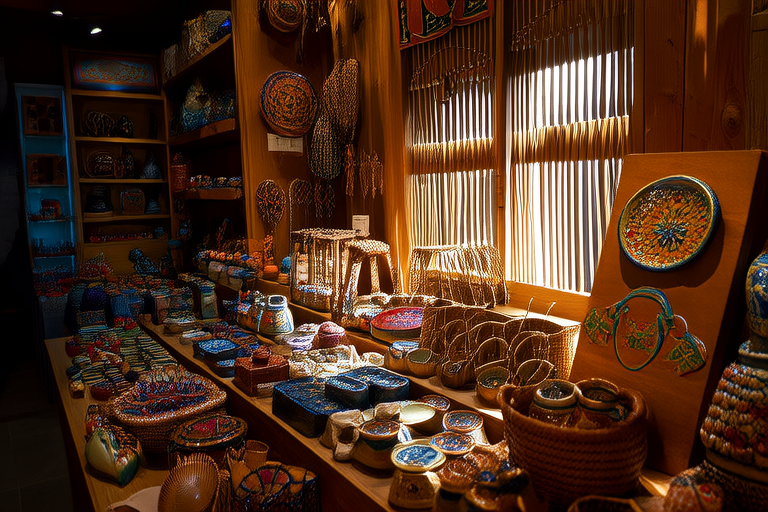Uncover Hidden Gems: Unique Souvenir Shops Around the World

Uncover Hidden Gems: Unique Souvenir Shops Around the World
Welcome to a journey across the globe where each stop reveals a treasure trove of unique souvenir shops. These hidden gems offer more than just trinkets; they provide a window into the soul of their respective cultures. From intricate handcrafted items to symbols deeply rooted in tradition, these shops allow travelers to bring home pieces of the world they’ve explored. This article will guide you through five diverse locations, each offering something special and memorable.
1. Japan: The Artisan’s Haven
Japan, renowned for its technological advancements, also boasts a rich heritage of craftsmanship. One such place is the Kyoto Traditional Crafts Center, nestled in the heart of Kyoto. This center showcases the work of local artisans who continue to practice ancient techniques passed down through generations. Visitors can find everything from delicate pottery and intricately designed kimonos to traditional tea sets and wooden toys. Each piece is imbued with the spirit of wabi-sabi, an aesthetic philosophy that celebrates imperfection and transience. The artisans here often share stories about their craft, providing insights into the cultural significance of their work. For instance, a beautifully crafted teapot might come with a story about the tea ceremony, an integral part of Japanese social etiquette that dates back centuries.
2. Morocco: A Blend of Colors and Textiles
Morocco, with its vibrant markets and bustling streets, offers a myriad of choices for the discerning traveler. In Marrakech, one finds the Souk el Attarine, a narrow alleyway filled with the aroma of spices and the sound of haggling merchants. Among the spices and textiles, visitors can uncover shops specializing in traditional Berber carpets. These carpets are not only works of art but also carry significant cultural weight. They are woven by nomadic tribes using natural dyes and traditional patterns that tell tales of their ancestors’ migrations. Each carpet is unique, reflecting the individuality of its weaver and the community it represents. Buying a carpet supports the livelihoods of these artisans and helps preserve their ancient traditions.
3. Peru: The Heart of Andean Craftsmanship
Peru, home to the Inca civilization, is steeped in history and culture. Cusco, the former capital of the Inca Empire, is a treasure trove of souvenirs that reflect this rich past. In the city’s central market, one can find shops selling alpaca wool sweaters and llama figurines. Alpaca wool has been used by Peruvians for centuries due to its durability and warmth. These shops often employ local artisans who spin and weave the wool by hand, preserving age-old techniques. Additionally, many shops offer miniature replicas of Machu Picchu, allowing visitors to take a piece of the iconic site home with them. These souvenirs serve as reminders of the incredible engineering feats of the Inca civilization and the enduring legacy of their culture.
4. Italy: Timeless Elegance
Italy, synonymous with fashion and art, offers an array of unique souvenirs that capture the essence of the country. In Florence, one can visit Le Botteghe di Via Tornabuoni, a collection of artisan workshops located along the city’s main shopping street. Here, visitors can find exquisite leather goods, hand-painted ceramics, and fine jewelry. Many of these items are created using methods that date back hundreds of years, such as the Florentine mosaic technique known as pietra dura. These shops often have a personal touch, with artisans working directly with customers to create custom pieces. Supporting these local artisans not only provides them with income but also ensures that these timeless crafts continue to thrive.
5. India: A Kaleidoscope of Culture
India, a land of contrasts and colors, offers a plethora of unique souvenirs that reflect its diverse cultural tapestry. In Jaipur, the Jewelers’ Bazaar is a must-visit destination for those seeking authentic Indian jewelry. Here, artisans create stunning pieces using traditional techniques, such as filigree and enameling. The bazaar is also home to shops specializing in Bandhani fabrics, which are tie-dyed using ancient methods. Each pattern tells a story, symbolizing various aspects of life and spirituality. Purchasing these items supports local artisans and helps preserve these age-old traditions. Moreover, it allows visitors to take home a piece of India’s rich cultural heritage.
Conclusion
Supporting local artisans and purchasing unique souvenirs is not only a way to bring home memories but also a means of preserving cultural heritage. By choosing to buy from these hidden gems, travelers contribute to the sustainability of traditional crafts and the livelihoods of skilled artisans. Whether it’s a delicate teapot from Japan, a colorful carpet from Morocco, or a handmade sweater from Peru, each item carries with it a story and a piece of the world’s cultural fabric. So, next time you travel, venture beyond the tourist traps and discover the treasures that lie within the lesser-known corners of the world.